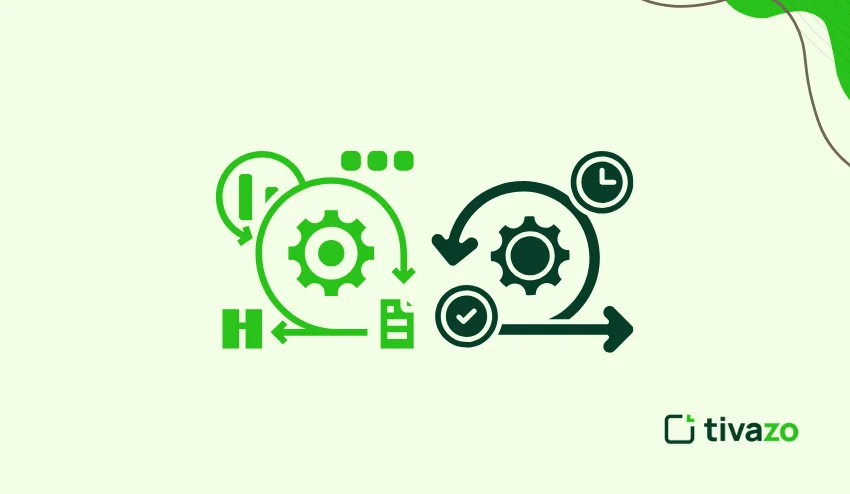Project Team Roles are the foundation of project management. The adage that says, “The whole is greater than the sum of its parts” rings true, now more than ever, with project management. Even the best talent cannot work well together without a defined set of project team roles. Imagine you were just sailing away on a boat without a captain or crew. It would be a mess.
When every team member knows their role and responsibilities, things run smoothly, collaboration is greatly enhanced, and success is much more attainable. This guide will cover every critical project team role, how to assign them, best practices, and tools to help you manage responsibilities.
Key Highlights:
- Definition of Project Team Roles
- Why Defining Project Team Roles Is Crucial
- Essential Project Team Roles and Responsibilities
- Additional Roles That Strengthen a Project Team
- Common Project Team Structures
- Assign Project Team Roles Effectively
- Tools That Support Project Team Roles
What are the Project Team Roles?
Project team roles are roles given to a group of individuals who have a common goal to successfully plan, execute, and deliver a project. Whether it be internal or external, every member comes together with their own skills, experiences, and their own expertise to be successful in reaching project objectives.
Key characteristics of a project team:
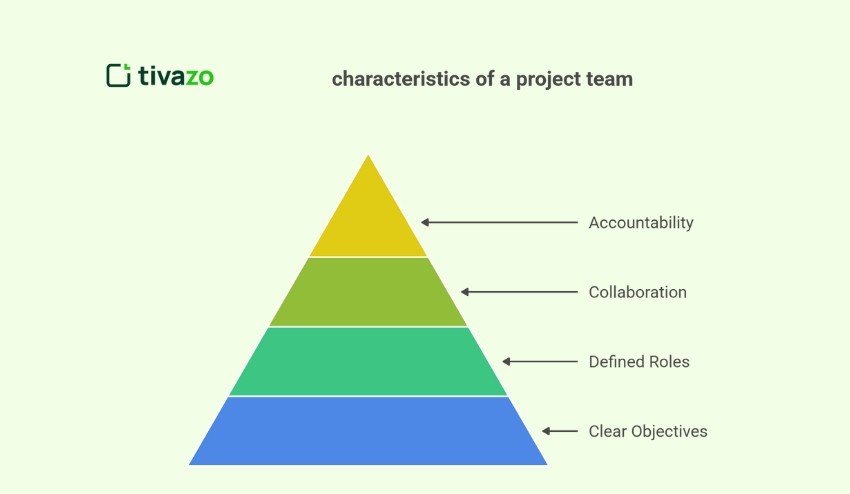
- Clear objectives: Every member understands the project goals.
- Defined roles: The tasks are assigned based on skills and responsibilities.
- Collaboration: Team members work together to overcome challenges and obstacles, and milestone planner tasks.
- Accountability: Each team member is accountable for their deliverable(s).
If a team does not clearly understand their project team roles, they risk miscommunication and misunderstandings, doubling up work, and ultimately missing deadlines altogether.
Why Defining Project Team Roles Is Crucial
Defining project team roles is an important part of the continuation of work, and it helps everyone to understand what their expectations are. Here are a few reasons why project team roles are important:
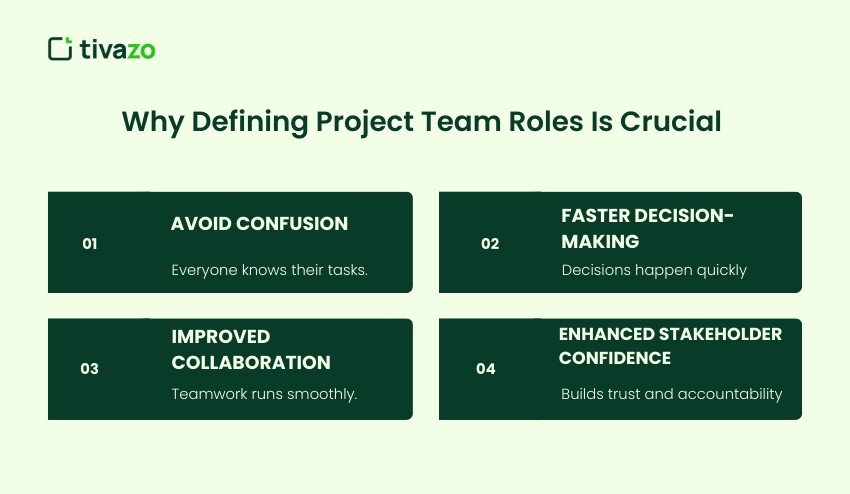
- Avoid Confusion
- When each team member knows what they are responsible for, there will be less overlap, and chances are there will be fewer mistakes. Members can concentrate on their own work, and they know who is working on what.
- Faster Decision-Making
- With clear roles in place, there won’t be any delays in approvals while waiting for someone to step up. If everyone understands their responsibilities and authority, approvals happen faster and problems are solved faster, and decisions are made faster
- Improved Collaboration
- Knowing what each team member is responsible for will make it more seamless for collaboration. The more each team member understands how their work connects with others, the better able they are to coordinate work and agree to help each other.
- Enhanced Stakeholder Confidence
- Stakeholders and clients will be able to see who is responsible for which part of the project. This transparency makes the project team look thoughtful, organized, and most importantly, accountable.
In summary, when project team roles are clearly defined,
7 Essential Project Team Roles and Responsibilities
Every successful project has a pre-defined team. Clear roles ensure everyone knows who is responsible for what, which keeps the project on track. Here are the 7 most important project team roles:
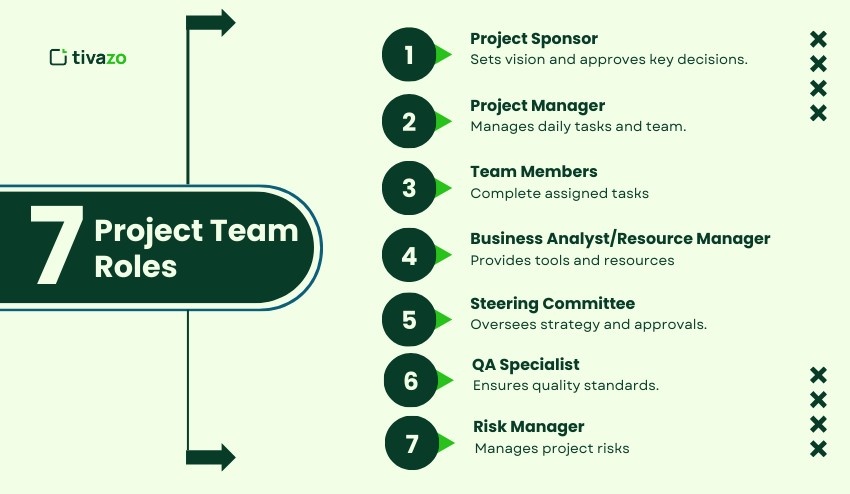
1. Project Sponsor
The project sponsor is the person who advocates for the project at a high level. They provide high-level direction regarding the project’s vision and make high-level strategic decisions. While adhering to the project sponsor, projects can stall or flounder without a clear set of direction or required resources.
Responsibilities:
- Define the project’s overall vision and objectives.
- Define S.M.A.R.T. goals to evaluate success.
- Execute approvals on budgets, major changes, and required resources.
- Remove hurdles impeding the team.
Example: For instance, the VP for a product launch ensures it aligns with the company’s public vision.
2. Project Manager (Leader)
The project manager plays the leading role daily. They ensure tasks are completed on time, with relative accuracy to those budgets, while motivating the team to stay engaged.
Responsibilities:
- Create a project plan and schedule in detail.
- Assign tasks based on members’ respective areas of expertise.
- Track progress and modify plans as needed when unforeseen issues arise.
- Communicate with team members and stakeholders regularly.
Example: A project manager organizes a software development team to ensure the developers, website designers, and QA continue to move forward.
3. Project Team Members
These are the people who carry out and perform the actual work. They will have specialized skills and work together to deliver project milestones.
Responsibilities:
- Deliver defined tasks on time.
- Report project updates, completions, and obstacles to the project manager.
- Work with other team members so that they do not hold each other up.
Example: Engineers, designers, and analysts working together to develop a new application or system. a new application or system.
4. Business Analyst / Resource Manager
These roles ensure that the team has the correct resources, appropriate tools, and necessary information, and have all that is needed to do their job. The analyst/resource manager also provides the connection between the project requirements and what the team is actually doing.
Responsibilities:
- To analyze project requirements and document resource needs.
- To identify and recommend tools, processes, and solutions as alternatives to improve value.
- To investigate and resolve resource-issue delays..
Example: A business analyst who defines and identifies which software tools the team will need to use to make the project as efficient as possible.
5. Steering Committee
The project steering committee is strategically supervising where the project is headed in achieving the business goals of the organization. They give big problems advice and direction on projects.
Responsibilities:
- Track the progress of the project in line with the organization.
- Mandate to Approve Scope and Budget Changes.
- Offer the project manager strategic advice at several key decision points.
Example: Detailed project status reports are reviewed quarterly by senior management, and priorities are adjusted.
6. Quality Assurance Specialist
Also, QA engineers take part in specifying project deliverables that meet the necessary quality standards. They help to prevent errors before they reach the client or end-user.
Responsibilities:
- Conduct tests, inspections, or quality checks.
- Spot process defects, voids, or inefficiencies.
- Suggest improvements and recommend to maximize quality.
Example: A QA engineer is testing a mobile application to make sure that it works as expected and satisfies the needs of the user.
7. Risk Manager
Every project carries potential risks. It’s the risk manager’s job to spot, track, and deflect these risks and threats so nothing is delayed or derailed.
Responsibilities:
- Evaluate possible threats and their impact on the project.
- Develop contingency and mitigation plans.
- Keep risk in the pipeline throughout the project lifecycle.
Example: Risk analyst overseeing regulatory risks in a healthcare project to avoid expensive fines and be in compliance.
Additional Roles That Strengthen a Project Team
The core project team has many of the critical responsibilities, but many projects benefit from specialized roles that supplement with additional expertise and oversight. These extra jobs ensure the project continues to function, meets high standards, and satisfies stakeholder needs.
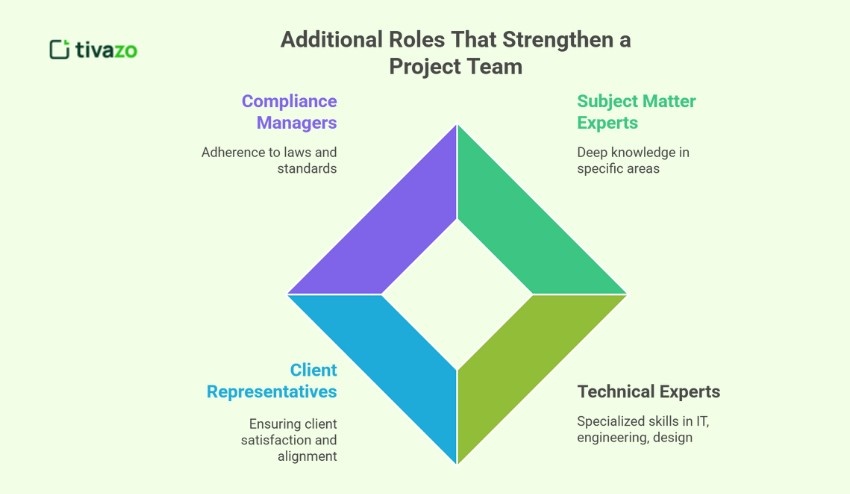
- SME (Subject Matter Experts): They do everything in terms of knowledge depth.
- Experts: Provide knowledge in IT, engineering, or design.
- Client Representatives: Make sure it is what the client is looking for.
- Compliance Managers: There are laws and standards to live by.
These positions bring many benefits with them, such as the ability to handle specific issues and avoid future potentially costly mistakes, while ensuring an overall better project result. Those roles become extra critical for complex, high-stakes, or heavily regulated projects.
Common Project Team Structures
Project teams can be organized in different ways:
| Structure | Description | Team members report to the PM & department head | Cons |
|---|---|---|---|
| Functional | Teams grouped by function | Specialized expertise | Slower cross-team collaboration |
| Matrix | Team members report to PM & department head | Balanced focus | Dual reporting can cause confusion |
| Cross-functional | Diverse skills in one team | Fast decision-making | Requires strong coordination |
Choosing the right structure depends on project complexity, size, and organizational culture.
How to Assign Project Team Roles Effectively
Assigning project team roles correctly is fundamental to a project’s success. When team roles are aligned with skillsets and responsibilities are understood, teams are more productive and avoid any confusion. Here is how to effectively assign project team roles:

- Assess Skills & Strengths
- First, determine each team member’s expertise, experience, and strengths. Knowing what role each person plays ensures that tasks are assigned accordingly.
- Match Responsibilities to Expertise
- After you have identified the strengths of your team, you can effectively assign roles and responsibilities. Assigning roles based on strengths improves quality and creates efficiencies when producing project deliverables.
- Clarify Expectations with a RACI Matrix
- A RACI matrix helps define who is Responsible, Accountable, Consulted, and Informed for each task. This ensures everyone knows their level of involvement and prevents overlap or gaps in responsibility.
- Communicate Clearly to All Stakeholders
- We establish clarity through transparency. Roles and responsibilities should be shared with the whole team and stakeholders, so everyone is clear who to approach for decision-making, updates, and approvals.
- Review Periodically as Project Evolves
- Projects evolve. Ensure roles and responsibilities are reviewed and adjusted periodically. By re-evaluating ownership posts it makes sure the team is adjusting efficiently to new priorities and challenges.
By taking the steps outlined above, you can maximize your team’s effectiveness by matching the right person to the right task, ensuring efficiency, and creating a smoother project journey.
Tools That Support Project Team Roles
Nowadays, tools can make a huge difference to how projects get done in high-tempo environments. Project team roles will be more effective when supported with digital tools to automate routine, task management, progress tracking, and communications.
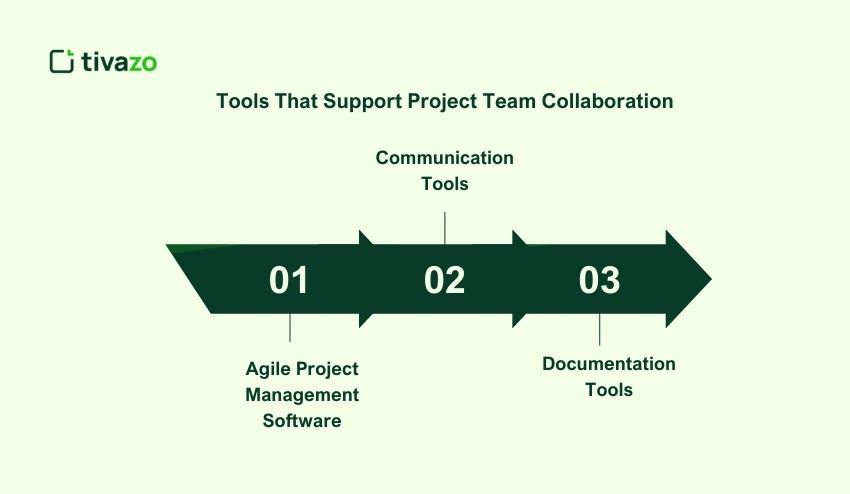
- Agile Project Management Software:
- Asana, Trello, Jira, and Tivazo provide agile project teams with the ability to plan, prioritize, and move tasks quickly. Agile project management tools enable teams to visualize workflows, assign responsibilities, and monitor deadlines in real time.
- Communication Tools:
- Slack and Microsoft Teams are great tools to keep teams engaged. Even if team members are remote workers, these platforms create group channels with instant messaging and video call functionality to discuss critical issues, share updates, and collaborate on tasks in real time.
- Documentation Tools:
- Google Workspace and Confluence help teams to create, store, and share documents that are important to a project. Spreading information across hundreds of emails increases the chances of team members using out-of-date files or instructions. Having key documents stored in one place enables teams to use the most updated files.
Using these tools in tandem enables the PM to clearly delegate, effectively monitor, and hold members accountable, resulting in a smoother and more efficient project workflow.
Conclusion
A project is successful when all involved roles know exactly what’s expected of them. Role definition of the project team enhances effectiveness, minimizes conflicts and meets project deadlines and budget targets. Transparent roles increase accountability, foster cooperation, and offer stakeholder assurance. Add to all of this open communication, a supportive team culture, and the right tech such as Tivazo, then your team is a high-performing unit that can deliver projects time after time.



